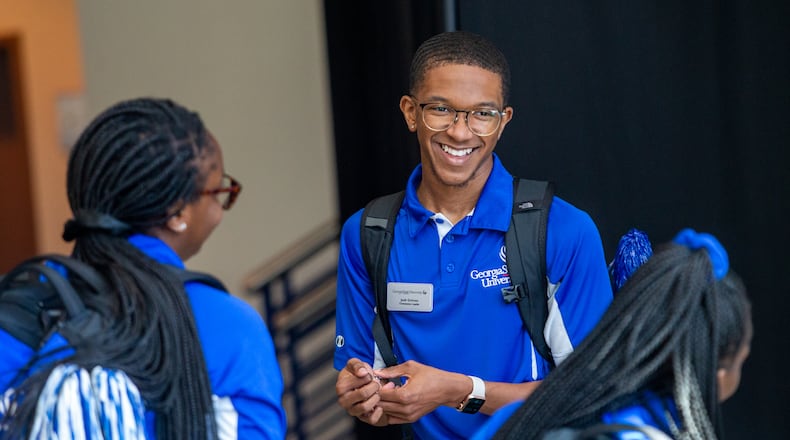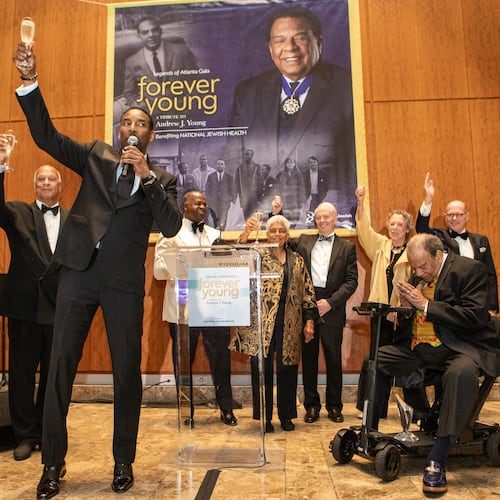Historically Black colleges and universities were established in the United States to provide educational opportunities for Black people who had limited, if any, access to higher education. They were designed not only to provide access, but also community.
As times changed, access to a broader range of educational opportunities became available and Black students began to take advantage of them.
While HBCUs are still an essential piece of the higher education landscape, only 7% of Black students attend HBCUs, according to The U.S. Department of Education.
Black students at PWIs and non HBCUs often find themselves in search of the comfort of community. In some cases, the community is waiting for them. In others, students have to create it on their own.
At Emory University, Myles Dunn found his community waiting for him on the fifth floor of the Hamilton Holmes building – The Black Men’s Initiative Immersion Community. The program was created as a resource for incoming freshmen, supporting Black men with university resources and spaces that are designated for them.
According to Dunn, who originally wanted to attend Morehouse College, the Initiative’s existence went against his previous conception suspicions of what going to a PWI would be like.
“I really didn’t know what to expect,” Dunn said. “... I never had to really interact with non-Black people for the majority of my life. So learning how to navigate that was something that was very daunting for me coming in.”
As an Atlanta native, the experiences Dunn had at his prior schools were distinct. The majority of his classmates looked just like him. Going from a predominantly Black elementary, middle and high school to an institution where the Black students made up 14% of the student body was uncharted territory.
For many Black students at PWIs, it is intentional spaces like these that are pivotal in finding and fostering community. For Dunn, it was proof that he was not alone.
“Everybody on that floor were Black men,” Dunn said. “And that made my transition into Emory a lot easier, because I was surrounded by a group of Black men like myself, and like-minded individuals, who were all going through the same things.”
Emory’s Black Men Initiative was recently expanded to include the Black Women’s Immersion Community – a community open to students of any race or national origin who demonstrate a commitment to Black women’s academic or social success. It is an opportunity for like-minded individuals to make connections, and “be able to articulate a positive identity for themselves in relation to the Emory community,” according to the Women’s website.
Credit: Christopher Moore
Credit: Christopher Moore
Black Student Organizations
One of the prominent tools utilized by Black students everywhere is BSO’s – Black Student Organizations. At Emory, Georgia Institute of Technology, and even at the Atlanta University Center’s HBCUs, these organizations cater to the various interests of Black students on campus.
In early October, The Office of Minority Educational Development for Georgia Tech hosted the 2024 Welcome Carnival to display the various Black Student Organizations offered on campus.
Standing at the third table along the quad was Leah Lockhart, a third-year Industrial Design major, who recently founded Black Students in Design for Georgia Tech. Lockhart started BSID to address the lack of representation of Black students in design-related fields. She is among the many who have taken the initiative to establish community where there seems to be none.
“We have the freedom to create whatever organization we want on campus,” Lockhart said. “Why not create an organization geared towards people like me, Black students that are interested in design, that are interested in architecture, that are interested in those skills.”
Recently, the Immunity Vanguard was created to house all of the BSOs at Tech and foster connection among them. Their collaboration is seen in their back-to-school events, joint club events, tailgates and most notably, Homecoming.
A Homecoming tailgate is hosted each year with Black greek organization tents set up across the lawn. At Georgia State, BSOs also participate in a Homecoming Parade showing off each organization. According to Dunn, it is events like these that reminded him he was not too far from home.
The non-HBCU experience
It is not only PWIs that find Black student organizations are pivotal. BSOs are also represented at schools like Georgia State, which are not HBCUs, but are also not PWIs either. At Georgia State, Black students make up the majority of the student body, according to the school’s website.
HBCUs make up only three percent of the country’s colleges and universities, according to The United Negro College Fund. And due to the underfunding of these institutions, attending an HBCU can be a luxury that some people cannot afford.
Though ninety percent of undergraduate students at HBCUs received some type of financial aid in 2019-20, according to The National Center for Education Statistics, the average amount received from grants was $9,200. The average tuition for an HBCU in Atlanta was $27,694, not including the Morehouse School of Medicine.
Approximately half of all HBCUs are also private, meaning that state programs like Zell Miller and the Hope scholarship cannot be applied as financial aid.
For Samir Seymour, the president of the Georgia State Black Student Alliance (BSA) and a member of Alpha Phi Alpha Fraternity, the oldest Black fraternity, financial aid was a factor in the decision making between Clark Atlanta University and Georgia State University. However, the presence of community was not, It was waiting for him at the BSA.
After choosing Georgia State, though he did not have to go far to see people who looked like him, Seymour still had to make the effort to find his smaller community within.
“Crazy enough, the first organization that I joined was Black Student Alliance,” Seymour said. “For me, coming from a different city and not really knowing anyone in Atlanta, and then meeting them and just starting to build that community and that relationship over time, I’m forever grateful.”
Founded in 1962, BSA is a collective that aims to unite students from diverse backgrounds throughout the Black community. According to Seymour, the group works to “redefine Blackness” by breaking the cultural barriers between race and ethnicity.
Credit: Jenni Girtman
Credit: Jenni Girtman
BSOs are typically set up in a way that groups people together based on their home country, major, hobby or external interest. BSA distinguishes itself from the other organizations by emphasizing a connectivity between all of the different groups.
“We try to reach all different countries, different languages, Afro-Latina, Afro-European, African American, and we try to bring them together to show that there’s really no barrier between us all,” Seymour said.
Because not every school in the Metro Atlanta area has BSA, Seymour has thus made it his mission to make it an organization that everyone has access to, even if it’s not on their campus.
“Bringing BSA to the metro area of Atlanta could change someone’s outlook of their organization on their campus,” Seymour said. “Some people might not be having the same experience as we do at Georgia State, but if we were to connect with them, maybe they could help us in certain areas, and we could give them tips as well.”
Organizations centered around connecting people of similar identities and interests are not uncommon at schools in the Atlanta area. In addition to BSA, Georgia State has Chabad of GSU, A Jewish student organization, Asian American Student Association, Brazilian Student Association and more.
“Growing up, there was always a heavy emphasis on HBCUs,” said Dunn, an Emory graduate. “But it shouldn’t be presented in a way that if you go to a PWI, it is going to be the worst experience you’re going to have, because that wasn’t my case at all.”
Become a member of UATL for more stories like this in our free newsletter and other membership benefits.
Follow UATL on Facebook, on X, TikTok and Instagram.
About the Author
Keep Reading
The Latest
Featured





